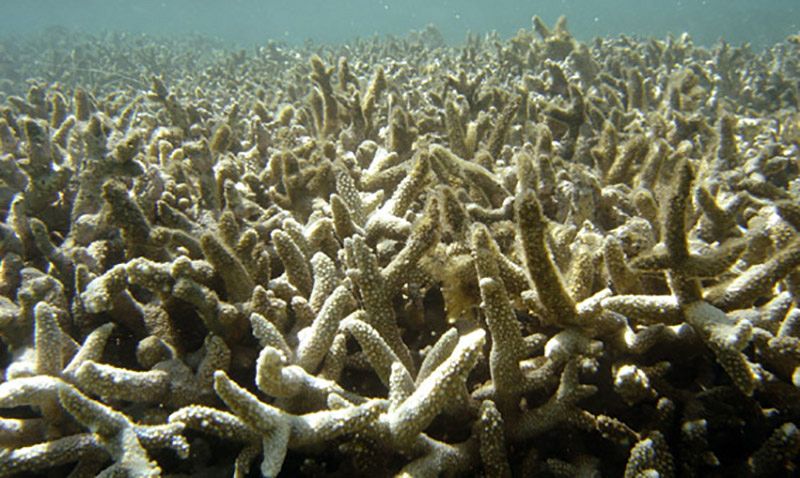Despite small measures being taken to prevent the demise of our Great Barrier Reef, it may well be too late to save it.
ONCE A YEAR, coral in the Great Barrier Reef spawns. It is an amazing feat of nature and describes the beauty and the wonder of the 2,900 individual reefs in the area off the Queensland coast in Australia which has been so vivid and full of life.
The tiny eggs and sperm called gametes which are released by the coral into the water meet and become planula, floating in the water for days and weeks until they find a hard surface to attach to. It is an important part of the regeneration of the Reef and the synchronicity occurs according to very specific lunar cycles to ensure that the male and female gametes can meet. Nature’s miracles aren’t always as beautiful and so enchanting.
I swam in the Great Barrier Reef so often in my early teens that I had to wear earplugs to protect my ears from coral spawn and other floating sea matter. I would spend hours duck-diving into the water at the beach wearing a snorkel and mask so I could look at the coral and fish. It’s saddening to imagine the Great Barrier Reef not being there and other people missing the opportunity to experience the Reef as I did. Being underwater in the Great Barrier Reef ocean when visibility is high is a unique experience.
Most people in Australia are aware of the damage that has occurred to the Great Barrier Reef due to bleaching of coral caused by climate change-related increases to water temperature and other specified impacts such as poor water quality. Forty-five key impacts have been identified recently. The value of the damage can be hard to comprehend.
The Great Barrier Reef was placed on the World Heritage List in 1981. It is number two on the Natural Wonders of the World list, a prestigious list that includes the Grand Canyon, Mount Everest, The Harbor at Rio de Janeiro, Victoria Falls, Paricutin Volcano and the Northern Lights. The area spans over 2,500km with approximately 900 islands — the equivalent distance of driving from Melbourne to Sydney and back again. 10% of the area is comprised of coral gardens.
It has been estimated recently by the ARC Centre of Excellence for Coral Reef Studies at James Cook University that only 7% of the coral reefs have not been impacted by bleaching. Bleaching can be reversed if the water temperature improves quickly enough, otherwise the coral dies.
Progressively since 1998, the Great Barrier Reef has been dying. In this year, it was estimated by scientists from the ARC Centre of Excellence that 42% of the Reef bleached, turning white. Under stress, the coral expels the colourful algal food source from within its tissues, which provides nourishment and starves itself.
Four years later in 2002, 54% of the Reef had bleached. Ecosystems can progressively adapt, but this adaptation is not always mutually facilitative and it can be like a tumbling tower game — when you take one block out and move it to the top of the tower, you need to hope that the rest of the blocks stay in place.
The death of one part of the Great Barrier Reef ecosystem can lead to the other parts of the ecosystem dying. Further coral bleaching occurred in 2016 and 2017. Coral spawning continued, assisting areas to regenerate and offsetting some of the damage caused by the bleaching. In 2016, a coral IVF technique was piloted for the first time on the Reef.
In 2018, the pilot was expanded via the Larval Restoration Project, providing hope that the technique would allow the coral to survive and evolve whilst long-term solutions for climate stabilisation could be found. Scientists found in 2016 that approximately 60% of the corals in the northern part of the Reef had died and, in some parts, all corals had died. Bleaching had eased towards the south of the Great Barrier Reef and the coral was recovering.
Solutions have yet to be found to rescue the Great Barrier Reef. In its current state and considering its historical rate of deterioration and size, it’s unlikely this will occur quickly enough. Legislation was enacted by the Queensland Government in September 2019 to limit the amount of agricultural run-off from farms into the sea. The Federal Senate has announced an inquiry into whether farming and poor water quality have contributed to the poor outlook for the Great Barrier Reef.
The long-term aim is to manage the risk of climate change and the forecast 2.5°C increase in temperature by 2100, estimated by the Intergovernmental Panel on Climate Change. The Great Barrier Reef Marine Park Authority reports that ocean surface temperatures on the Great Barrier Reef have increased by 0.4°C over the past 30 years. In 2016, the temperature was the hottest ever recorded for February, March and April. The ocean temperature differs across the 2,900 individual reefs, making the task non-uniform. The 2,500km of ocean water needs to stay cooler.
I pondered several solutions. A large ship which converts sea water to ice could deposit ice back into the ocean. Digging holes in specific places could add cooler, deeper water to the ocean and have an overall cooling effect. Towing in an iceberg from Antarctica could melt and cool the water. Brainstorming and creative thinking are needed. In December 2018, the Brisbane Times reported that eight giant fans to cool water and reduce heat stress would be trialled as a potential solution. The solution does not need to be complex, it needs to be effective and sustainable. People are welcome to contribute ideas. The opportunity for Australia to find a viable solution and lead in climate change Reef recovery efforts continues.
In 2018, Bill Ferris AC, the Chair of Innovation and Science Australia, recognised the importance of the Great Barrier Reef and created a vision for Australia to aspire to.
He stated:
‘As one of the natural wonders of the world, the Great Barrier Reef is iconically Australian, so where better to demonstrate the power of science and innovation in solving big challenges and providing economic, social and environmental benefits to future generations of Australians, not to mention the rest of the world.’
Preventative urgent measures and results are needed and then proven long-term results and continuous improvement can be pursued. In addition to water temperature cooling, coral regenerative techniques need to be considered. The solution will be multi-faceted and adjustable according to the characteristics of specific areas, yet simple due to the size of the area and preferably transferrable to other countries and reefs.
The Great Barrier Reef Foundation reports employment supported by the Great Barrier Reef is more than the four Australian banks combined and the Reef indirectly and directly provided $6.4 billion and over 64,000 jobs to the Australian economy in 2015-16. It is home to over 400 types of coral, 1,500 species of bony fish, the dugong and green turtle which are under threat of extinction and 4,000 types of mollusc according to UNESCO, which placed it on the World Heritage List.
Mass coral spawning usually occurs one week after a full moon. The time and month have been found to be dependent on sharp increases to sea temperatures by the team at the Centre of Excellence for Coral Reef Studies. If the natural synchronicity of the tiny eggs and sperm released into the water changes, then it is possible that decoupling of processes and disruptive adaption may occur, impacting the ability for the gametes to survive in the water, meet and form planula and then attach to hard surfaces. Spawning has also been found to occur more than once a year, discovered by the University of Queensland and the CSIRO, which assists with regenerative and genetic resilience of the coral and reef.
Despite this phenomenon and other ideas providing some hope, the outlook for the Great Barrier Reef has progressed from poor to very poor according to a recent August 2019 Great Barrier Reef Marine Park Authority government report. The coral in the great, majestic underwater wonderland on Australia’s doorstep may die due to continued deterioration, one-off mass bleaching events, lack of resilience or neglect, mismanagement and inaction about climate change. The end would be devastating. The Great Barrier Reef has a temperature and the prognosis is not good.
Then they came for the oceans, and I did not speak out—because the oceans are so big we can dump whatever we want into them.https://t.co/5IA7hN0s8Y
— fabe (@fab_earth) October 22, 2019
Great Barrier Reef, being bleached to death
-> pic.twitter.com/kJ8fOFosyV
 This work is licensed under a Creative Commons Attribution-NonCommercial-NoDerivs 3.0 Australia License
This work is licensed under a Creative Commons Attribution-NonCommercial-NoDerivs 3.0 Australia License
Support independent journalism Subscribe to IA.












